
Hannah Paperno/Tasting Table
The most quintessential and easy home-cooked meal is a plate of noodles with red sauce. It’s a quick weeknight dinner, a staple at potlucks, and perfect for carbo-loading before major sporting events. Whether you’re adding meatballs, sausage, or freshly grated Parmesan, it’s the marinara sauce that makes the meal. Given the number of pasta sauces available on the market, it’s impossible to know which one tastes the best without a lot of trial and error. To make everyone’s lives a little easier, I decided to test as many store-bought pasta sauce brands as I could find to see which one was best.
I generously spooned each brand’s standard marinara sauce over hot, fresh spaghetti. After taste-testing and comparing each pasta sauce based on factors like taste and texture, I can confidently say which ones are the worst and which will leave you coming back for more.
Some recommendations are based on firsthand impressions of promotional materials and products provided by the manufacturer.
15. Bertolli
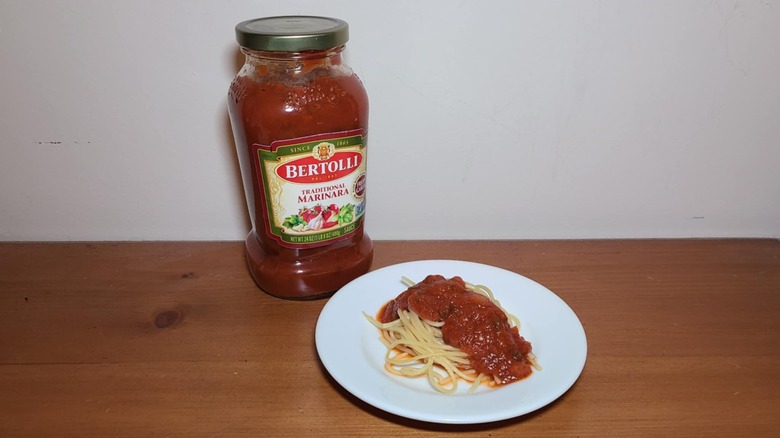
Hannah Paperno/Tasting Table
Bertolli is a popular pasta sauce brand and a staple on store shelves. In addition to sauce, Bertolli also sells oils, vinegars, and frozen meals. It’s one of the cheaper bottles of pasta sauce, regardless of which variety you choose to bring home. That said, I’m not sure it’s worth it.
I’m here to put an end to the hotly debated topic of whether sugar belongs in pasta sauce — it does not. Sugar was the only thing I tasted in this Bertolli sauce. The texture was just okay, and all I could focus on was how sweet it was. Perhaps if this was the only sauce I tried, I wouldn’t have noticed it so much. But trying it back-to-back with other, heartier, more savory sauces made it stand out in a bad way. I would liken the flavor to a slice of tomato with sugar poured on top of it, almost like you might eat a grapefruit. If there was anything else to taste in this sauce, it was completely masked by the overwhelming sweetness.
14. Prego
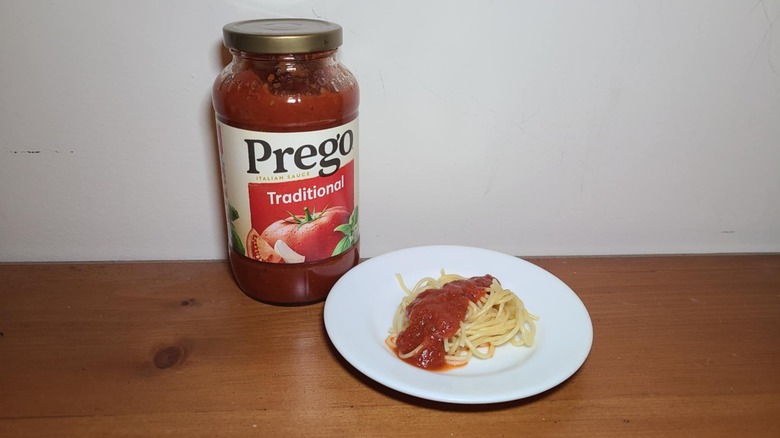
Hannah Paperno/Tasting Table
Prego, which is owned by Campbell’s, is one of the more affordable pasta sauces at the grocery store. It offers a wide range of sauces intended for all types of Italian food, including cheese-based sauces that are great for veggies, potatoes, or mac and cheese. However, I wanted to focus on its traditional red sauce.
On a positive note, I was a fan of this sauce’s texture. It was very homogeneous and well-blended, with a few tomato chunks here and there. That said, I felt the sauce was far too sweet. My very first impression of the sauce was that it tasted like sugar and oregano. I wasn’t able to taste much else beyond that, which was quite disappointing. Prego does sell a “no sugar added” version of its traditional sauce, which may have been better, but it was not part of this taste test. Its texture was decent, and I appreciated that I could taste some herbs, which is why it ranks higher than Bertolli.
13. Ragú

Hannah Paperno/Tasting Table
Ragú is a family-owned brand that brought its sauce recipe from Italy to New York. It’s known for offering variety, affordability, and “old world-style” recipes. You may have tried it in a pinch, and its classic yellow lid is easy to recognize. For this review, I wanted to focus on its old world-style marinara sauce — which is meant to “[taste] like it’s been passed down for generations.”
It’s been years since I’ve had a Ragú sauce, and this review made me remember why. The texture was just okay. It was blended well, but was quite thin and watery. It also lost me on the flavor. The sauce was sweet, but not as overwhelming as the lower-ranking sauces. Otherwise, there wasn’t much else in terms of flavor. Even some reviews on the website claim that this sauce is thin, sweet, and bland. It wasn’t the worst of the sweeter sauces, but I wasn’t particularly impressed, either.
12. Muir Glen
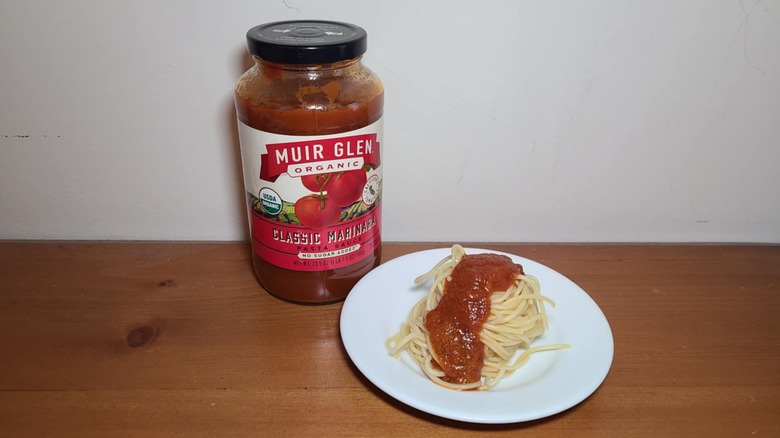
Hannah Paperno/Tasting Table
Muir Glen is owned by General Mills, which makes family favorites like Cheerios, Chex Mix, Pillsbury, and more. It sells pasta sauce along with other tomato-based products, and it’s always certified organic. But don’t let the label fool you — organic doesn’t always mean better.
Muir Glen’s marinara sauce surprised me, but not in a good way. For reasons I can’t explain, the first bite tasted like donuts. It wasn’t so much that it was sweet, but there was something about it that reminded me of a trip to Dunkin’. The sauce does not include added sugar, so I can’t say where the flavor came from, but it left me confused. I taste-tested it a second time, and even a third, and that initial flavor was still there.
Once I got past that, I picked up on the black pepper and tomatoes more. The texture was good and not too thin, but I was completely caught off guard by the initial flavor. The texture and lack of added sugar helped it rank higher than Ragú; however, this may just be an instance of “you’ll have to try this one yourself.”
11. Classico

Hannah Paperno/Tasting Table
Classico is a pasta sauce brand owned by Kraft Heinz, which also owns brands like Bagel Bites, Oscar Meyer, and Philadelphia. From my own experiences at my local grocery stores, Classico pasta sauces land somewhere in the middle in terms of affordability — it’s not the most expensive brand on the shelves, but it’s also not the cheapest.
Overall, the tomato and basil sauce I tried was just fine. I chose a tomato basil red sauce because, despite the variety of flavors listed on the Classico website, the only jar I could find that said “marinara” was a cabernet sauce that was too far from a traditional sauce to include. The sauce was on the thinner side — without being too watery — and was overall pretty flavorless. According to its ingredients list, it has less than 2% salt, basil, and garlic, making it taste very close to just tomato sauce. It isn’t necessarily a bad thing, but when compared to more flavorful sauces, this fell flat. Its lack of added sugar boosted it up in the ranking, but it definitely wasn’t the most flavorful sauce on this list.
10. Newman’s Own

Hannah Paperno/Tasting Table
Newman’s Own, founded in 1982, aims to “[transform] the lives of children who face adversity.” 100% of the profits go toward charitable causes, including nutrition education and programs for children with serious illnesses. If nothing else, you know that when you’re purchasing Newman’s Own, you’re making an impact on the community.
The flavor of Newman’s Own marinara sauce was relatively unimpressive. Although oregano is last on its ingredient list, it’s the most prominent flavor. Otherwise, it tasted very bland. The texture, however, was homogeneous and stuck to pasta very well. The tomato flavor was muted, and after reading the ingredient list, I was stunned to see it contained carrot puree. I’m not entirely sure why that ingredient was added, but it’s definitely not part of a standard marinara. That said, the texture helped it rank higher than Classico, even though it was just as bland.
9. Carmine’s
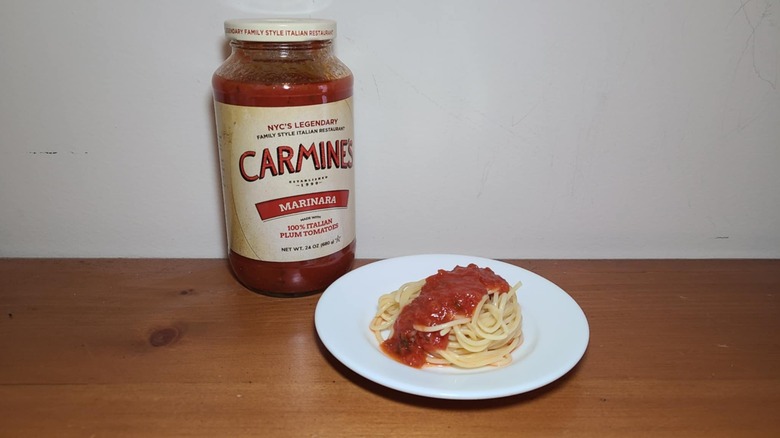
Hannah Paperno/Tasting Table
Carmine’s has made a name for itself in the restaurant industry, thanks to its delectable Italian food. It sells four pasta sauce flavors in stores, so you can enjoy the Carmine’s restaurant experience at home.
I’ve tried (and loved) Carmine’s vodka sauce before, so I was curious to see how it compared to the classic marinara. Unfortunately, this sauce left me a little disappointed. It was a little watery and heavy on the garlic. I’m someone who loves garlic, but I was unfortunately unable to taste anything else besides it. If it had been marketed as garlicky, then I would’ve had different expectations. It was a bit too heavy-handed for a marinara. Overall, I would label this sauce as just okay. It wasn’t bad, and there’s definitely a market for a garlicky sauce, but I felt it was poorly represented.
8. Barilla
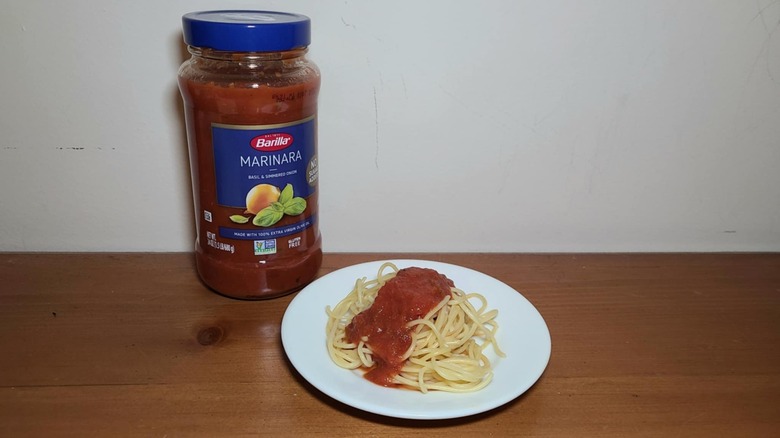
Hannah Paperno/Tasting Table
Barilla is a brand I know and love; I cook its pasta regularly. The brand got its start in Italy in the late 1800s and is now a household name. It sells many pasta shapes and types, and every so often comes out with a fun, unique innovation, like heart-shaped pasta for Valentine’s Day or snowflake pasta during the winter. Barilla has made its mark on the Italian food industry, so I was excited to see how its sauce stacked up against the others.
Oregano was one of the first things I noticed, in both the sauce’s aroma and flavor. It wasn’t as present in the other sauces I tried. Oddly enough, it reminded me of childhood because it tastes like the sauce on pizza Lunchables. It’s thin, which isn’t necessarily my preference, but I know some people enjoy it that way. Regardless, it was a decent sauce. It was a little heavy-handed on the oregano, but not too overpowering.
7. Botticelli
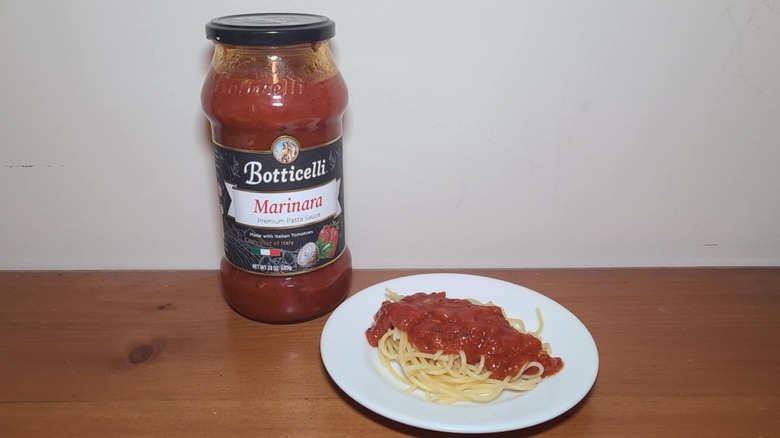
Hannah Paperno/Tasting Table
Botticelli seems to be a jack-of-all-trades brand — it sells pasta sauces, jarred vegetables, olive oil, and even coffee. It’s a family-owned business that started with olive oil and branched out to a wider range of Italian-inspired products. It sells 10 different flavors in various sizes, but I tried its marinara for this review.
Overall, this sauce tasted very middle of the road. It had a nice texture, and I loved that I could see chunks of garlic throughout it. Other than that, there wasn’t much to write home about. Its seasoning and texture didn’t stand out in a bad way, which is why it ranks above Barilla. I didn’t find that it was too sweet or too heavy-handed with any one flavor. It was a good sauce — not great, but definitely not bad.
6. Carbone
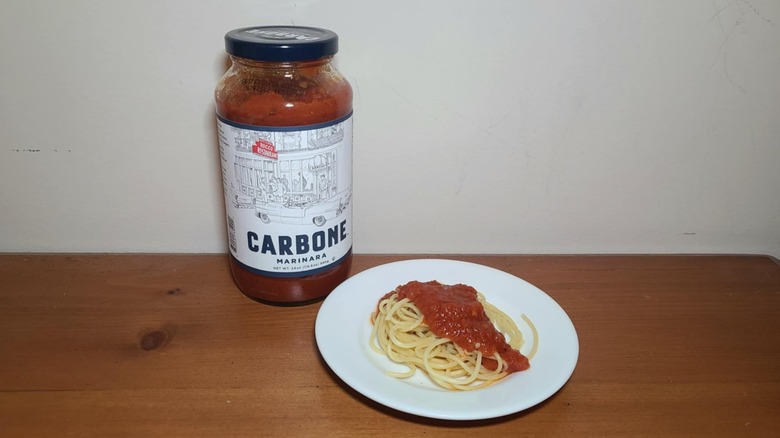
Hannah Paperno/Tasting Table
Carbone is another name on the list of new-to-me brands. It’s an Italian-American restaurant located in NYC that has now expanded to retail. Founded by namesake Mario Carbone, the restaurant aims to revive classic Italian-American dishes that were popularized in the 20th century.
Even though some may argue that Carbone is better than Rao’s, I would have to disagree. Carbone makes a great sauce, but it’s by no means the best marinara I’ve ever tasted. It had a great, thick texture without being chunky, and clung to the pasta well. My only critique is that I found it to be a little under-seasoned. I loved being able to taste the tomatoes fully, but I just wish there was a little something more going on, which is why it ranks near but not on the top of this list.
5. Trader Joe’s
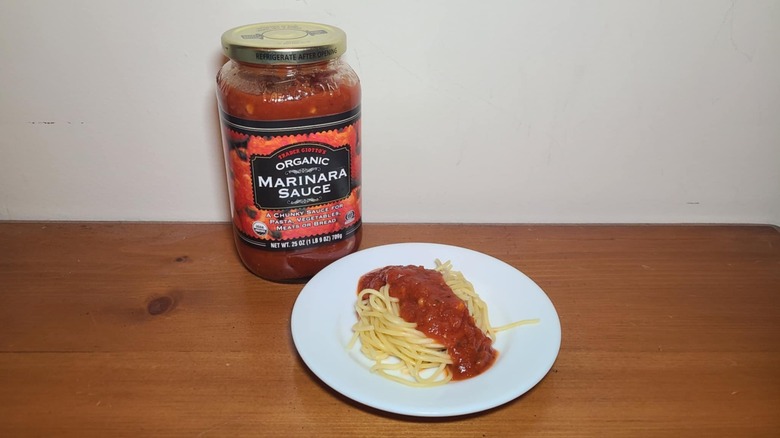
Hannah Paperno/Tasting Table
Trader Joe’s sells just about everything, so it’s no surprise that it has its own pasta sauces, too. Trader “Giotto’s” organic marinara sauce features California tomatoes, Parmesan cheese, onions, garlic, and spices. Of the sauces on the list, it is the only one with cheese, which makes it stand out. It also lives up to the “chunky” description on the label without being too thick.
Overall, this sauce had a great texture. I could taste the garlic and onion clearly, and the herbs and spices were very recognizable. It didn’t have the acidity that I was so in love with in the Rao’s sauce, but it was still very good. It ranks where it does because it was a genuinely delicious sauce; however, I’m not sure I would necessarily classify it as a standard marinara. Though the name suggests it is such, the Parmesan cheese deviates from the norm enough to move it down a few places from the top, while still ranking above some that are more authentic to the name.
4. Mezzetta
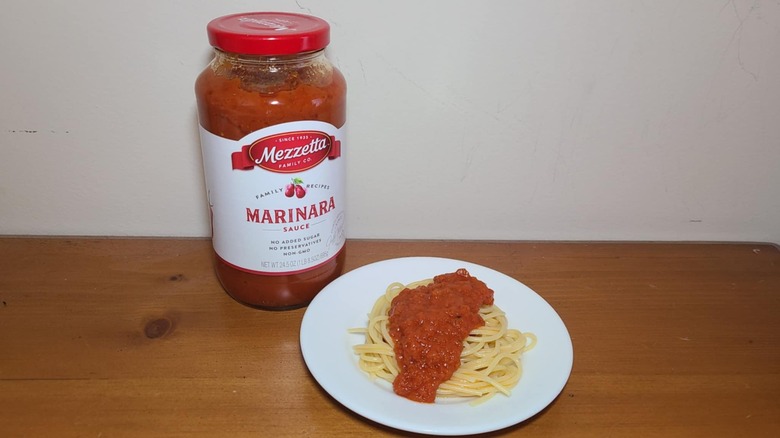
Hannah Paperno/Tasting Table
Mezzetta is another brand of sauce that I wasn’t too familiar with, but I was excited to try. It is a family-owned business founded in 1935 by Giuseppe Mezzetta, who immigrated from Italy to California and missed the flavors from back home. I know this brand more for its jarred peppers, olives, and pickled vegetables, but it also sells pasta sauces, hot sauces, marinades, and olive oil. The brand has just about everything needed to make a full Italian meal.
From the first bite of the marinara sauce, I could tell that Mezzetta’s was good. It had a touch of sweetness but wasn’t overpowering. It was also a little thicker than some of the other sauces I tried, and the onion flavor was the most prevalent for this marinara, but not dramatically so. Overall, it was a hearty, slightly sweet, oniony sauce that I was genuinely quite a fan of, but its lack of acidity and more onion-forward flavor ranks it a little lower than some of its competitors.
3. Victoria
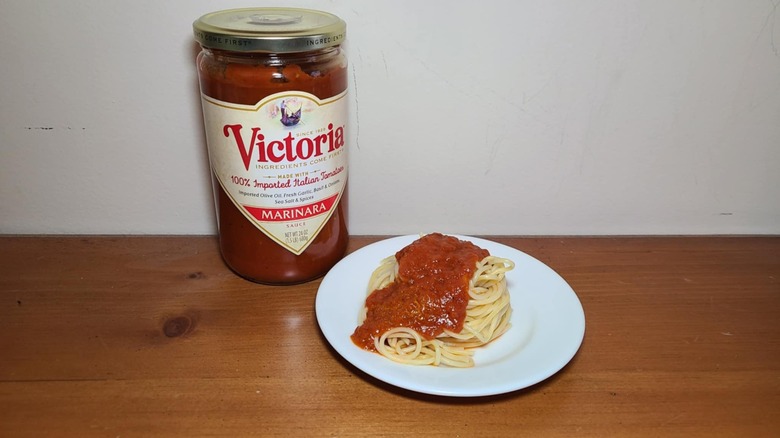
Hannah Paperno/Tasting Table
I’ve seen Victoria pasta sauce on store shelves before, but never had the inclination to try it. Prior to this taste test, I didn’t think there could truly be that many variations on the taste of jarred pasta sauce, but I was sorely mistaken. Aside from texture, the flavors vary widely, and Victoria seems to know how to do a marinara sauce right.
The best way to describe the Victoria marinara sauce is simple in the best way. It’s a bare-bones marinara sauce with no bells and whistles, just as it should be. Upon first bite, I immediately wanted to use it as a dipping sauce. It had the perfect taste for fried mozzarella sticks and would taste incredible being sopped up by garlic bread at the end of a meal. It was delicious, had a great texture, and tasted exactly like what you expect a marinara sauce to taste like. The onions, garlic, and additional herbs and spices didn’t overwhelm the palate, making sure the tomatoes were the star of the show.
2. Buitoni
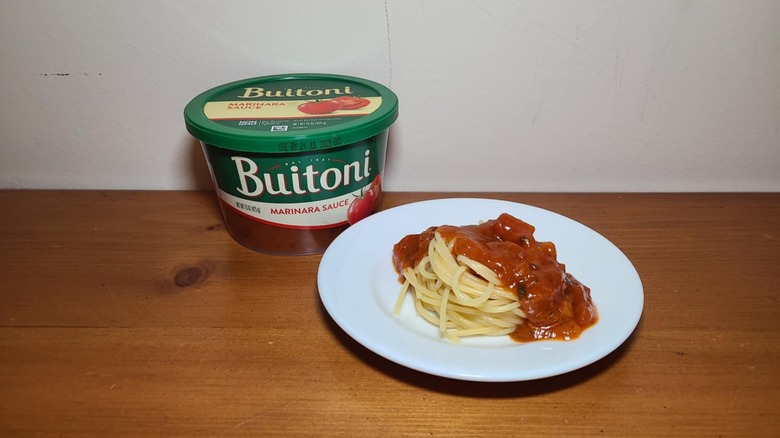
Hannah Paperno/Tasting Table
I’m a huge fan of pre-made tortellini and ravioli, so Buitoni was a brand I was already familiar with. The refrigerated section of the grocery store is likely where you’ll find the majority of its products. While the foods aren’t fully cooked, Buitoni sells various types of stuffed and flat pasta that can be easily cooked at home, making meal prep a breeze. Though I’ve tried the stuffed pastas countless times, I have never tried any of the sauces.
Buitoni pasta sauce was a struggle for me to even find in the grocery store, because it was the only one on this list that was sold fresh, but it was more than worth the hunt. The sauce had a great, thick texture that coated the pasta well. While there was some added sugar, it wasn’t overly sweet like some of the others further down the list. It had a good balance of flavor with onions, salt, and garlic puree while still heavily focused on the tomato. I felt these added flavors were slightly more pronounced than Victoria’s, which is why Buitoni outranks it. Ultimately, this was a sauce I felt I could just eat on its own with a spoon (and that’s exactly what I did).
1. Rao’s

Hannah Paperno/Tasting Table
Rao’s is a pasta sauce brand I already use pretty regularly, but it’s started to dip its toes into other areas of the food market, as well. From its standard pasta sauces, Rao’s has deviated to things like soups, frozen dinners, and ketchup, really making a name for itself with items found in multiple departments across grocery stores. Its sauce, however, is what it’s known for.
Though Rao’s offers a wide range of sauces meant for pasta, around two dozen to be exact, we’re focusing solely on its standard marinara pasta sauce. After going through 15 different sauces, I can confidently say that I’ll be buying Rao’s for life. The marinara sauce is simple, which is what makes it so good. Each jar is made with tomatoes, onions, garlic, basil, oregano, and olive oil. It’s the perfect texture, not too thick but not watery, the herbs are fresh and fragrant, and it sticks to pasta well without pooling at the bottom of the plate. It also has a slight acidity that I didn’t find as prevalent in any of the other sauces, which rounded it out nicely. This is, hands down, the best store-bought pasta sauce on the market.
Methodology

Hannah Paperno/Tasting Table
To decide which brands to choose for this review, it was important to cover those that hit all levels of affordability. From jars that cost just a couple of dollars to those that were closer to the $10-12 range, I wanted to cover a range of everything that can be found in a grocery store. I specifically chose anything labeled as a marinara sauce, or whatever each brand had as a “traditional” red sauce.
To taste each sauce, they were sampled in a variety of ways. To start, they were spooned over freshly cooked spaghetti noodles to see how each one interacted with pasta, and then were later tried on their own in individual spoonfuls. After each one, notes were taken on flavor, texture, first impressions, and whether or not it seemed to cling to the pasta. From there, sauces were ranked primarily on taste; however, texture was a big factor in where some of the sauces fell in the tier list.

